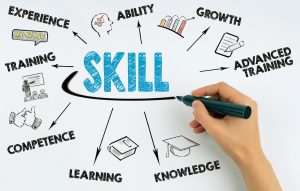
Leading Training – By Mark Lockett and Richard Baron
Training can move to the front of strategy development
Training departments are often thought of as the “tail of the dog.” Kind of harsh, but basically what that means is that training is not up front during the planning, strategy and decision making process, but at the back end. Marketing devises a strategy and rolls it out to sales. They also roll it out to training and say, “Here is our new strategy and accompanying resources; you need to train our people to be able to execute this at a competitive level.”
Sound familiar? While this may not be uncommon, there are significant challenges that it causes for our training teams.
The first challenge is trainer capacity. It’s hard to manage training team capacity if we are always in reactive mode, addressing business needs and “putting out fires.” Trainers go from critical need to critical need with not much of a break. This can result in trainer burnout and dissatisfaction with the job because they can never get to the things that they want to achieve.
The second challenge is lack of continuity and the impact of that on the learners. Marketing teams are constantly trying to increase sales by providing new information, new resources and new programs. While this is certainly understandable, many times they do not retire previous promotional resources.
It becomes a continuing drain on the training team to train to an increasing number of resources and educate the customer-facing teams on how to use them all effectively. Also, sometimes these new resources are a departure (strategically) from the previous ones and can create confusion for the learners.
The final challenge has to do with skills. Most trainers would agree that a high-quality sales interaction will deliver better results than multiple poor-quality interactions. As a result, we’d love to focus on skill development. The thing to consider is that it takes time and focus to develop skills. It’s not unreasonable to plan on a 12-month period to develop one to two new skills.
Unfortunately, if the trainers are focused on reactively addressing need after need, they do not have the time to build the necessary training and reinforcement to support that skill development and, in many cases, each new business need may take focus away from that skill development.
Making the Move
So how do we get ahead of this? How do we move from reactive to proactive? How do we get our internal stakeholders to understand and agree to focus on skill development to drive results?
While there is no single magic bullet, there is a way to get your stakeholders to start to think differently: conduct an annual needs analysis or your own version of a SWOT analysis (strengths, weaknesses, opportunities and threats). In this case, a SOC analysis: strengths, opportunities and concerns.
Conducting an annual needs analysis is a great way to be more proactive about addressing knowledge and skill needs and to align internal stakeholders with the value of focusing on these areas. Your internal stakeholders would like to hear that you are proactively planning to support their business objectives for the following year.
After the annual business planning cycle is completed, conduct interviews with the customer facing team leaders. Ask them to list the knowledge and skills that will be most important for their teams to have to meet the business objectives that have been outlined for the upcoming year.
You’ll get a lot of really great information — too much, in fact, to use everything! Reviewing that data with leadership and asking them to hone it down to the top two or three things to focus on for the following year (and why only two or three) allows you to get everyone on the same program. It also allows you to use this every time the marketers come back with something new; you can reinforce that these agreed-upon areas of focus should be a part of every new resource rollout.
Again, it’s not a magic bullet, but conducting an annual needs analysis is a great way to move to a more proactive training approach and to align your internal stakeholders on focused development areas.
Charting Your Moves
A SOC chart will help you engage in important dialogue with key stakeholders. List out the top five to seven strengths you are confident your stakeholders will agree with in terms of what your team brings to the table. Similarly list out the top five to seven opportunities you have identified that, if addressed, will have an impact on the business.
Lastly, and most importantly, list the five to seven concerns you have as the leader of the training team. These are the concerns that if not addressed will limit your team’s ability to impact the business positively and proactively.
The key to using the SOC with top stakeholders is that it affords you the opportunity to have a no holds-barred conversation. This is your opportunity to address anything that you believe is limiting your team’s ability to be successful. Your goal is to get alignment on what will be done to address the concerns and opportunities and commit to a plan of action that is unilaterally supported.
And just remember — you may need to remind key stakeholders about these conversations and agreements. Just saying.
Conclusion
Moving your training from reactive to proactive will require you as the leader to be bold. It is our job as learning leaders to proactively address opportunities to capitalize on and to address concerns that must be minimized.
After all, training is a key driver of the business, and your voice must be heard.

 Mark Lockett, marquis.lockett@sanofi.com, is head of training for Sanofi and a member of the LTEN Board of Directors.
Mark Lockett, marquis.lockett@sanofi.com, is head of training for Sanofi and a member of the LTEN Board of Directors.
Rich Baron, baronperformanceconsulting@gmail.com, is an executive learning leader and the former co-chairperson of the LTEN Learning Executive Committee.









